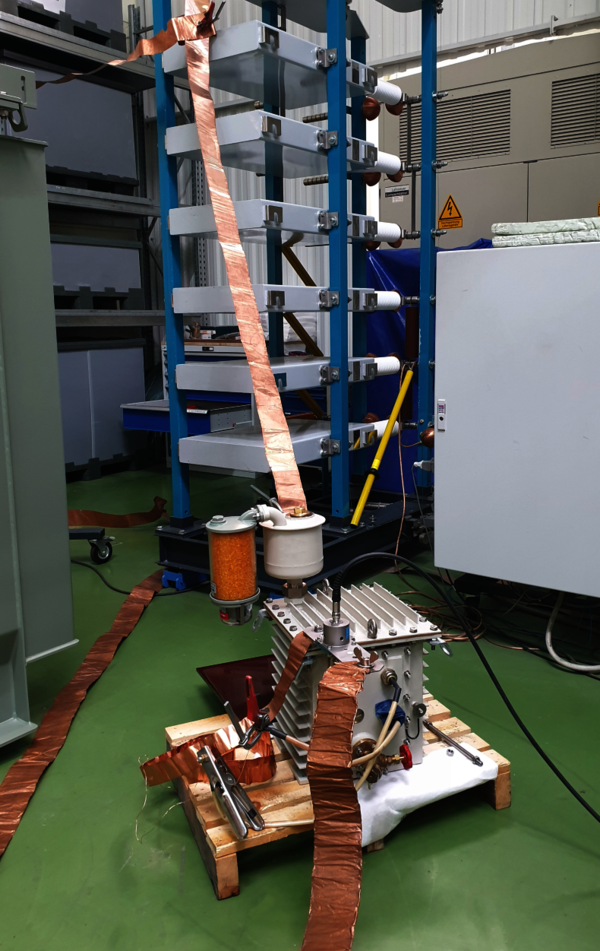Transforming our future electrical transformers
Andrea Cremasco defended his PhD thesis cum laude at the department of Electrical Engineering on June 26th.
![[Translate to English:] [Translate to English:]](https://assets.w3.tue.nl/w/fileadmin/_processed_/b/b/csm_Cremasco%20Banner%20image%20MFTassemblyAside%20V3_8d07593690.jpg)
Imagine a future where the problem of carbon emissions is resolved. Picture vast fields of solar and wind power plants generating clean electricity. Think of busy roads, where electric trucks, cars and buses run without harmful emissions, using highly-efficient electric motors. Integrating renewable sources into the power grid and meeting the electricity demands of this greener future requires upgrading our electrical supply chain. For his PhD research, Andrea Cremasco developed a medium-frequency transformer, partially made from biodegradeable materials, which could be a key aspect of safe, reliable, and efficient electrical networks in the future.
One of the main operating parameters of an electrical grid is voltage. To efficiently transport electricity over large distances, from the generation plant to the consumption site, the voltage is first raised to several tens of kilovolts, and then reduced to the level of the loads. A load could be a large industrial plant, or a high-power charging station installed along main roads for the ultrafast charging of electric cars and heavy-duty vehicles.
The electricity is normally generated by renewables at up to a few kilovolts, whereas medium voltage grids for electricity transfer operate between 6 and 35 kV. The transfer of electricity between different voltages is normally achieved using transformers, which therefore play a key role in our power grids.

Solid-state transformers for modern electric supply chains
The development of solid-state transformers (SSTs) is considered to be a milestone in the modernization of the electric supply chain. Compared to conventional transformers, these highly-compact power electronic devices offer additional features and smart functions to the grid, including the active control of power flow, real-time monitoring and protection. These functionalities are crucial for the continuous expansion of the grid while ensuring its flexible operation.
The safe operation of the grid requires the prevention of the propagation of overvoltages among interconnected networks. For example, this is necessary to ensure that the connected loads will never experience the hazardous effects of a lightning strike on a distribution line. One of these loads could be the charging station recharging your electric car, with you seated in while waiting for the vehicle to charge.
This capability is offered through the use of isolated SSTs, which guarantee the electrical separation between the interconnected networks, while allowing the transfer of energy.
So, is it the end for traditional power transformers?
The answer is no. Instead, it is the dawn of a new generation of transformers, known as medium-frequency transformers (MFTs), which provide isolation capability within SSTs. As such, MFT must follow similar insulation requirements as followed by conventional transformers. In other words, they have to safely operate with voltages of several tens of kilovolts. In this context, the term “medium-frequency” refers to the operating frequency, which can reach several tens of kilohertz. This allows for the shrinking of the size of the transformer, enabling superior compactness and lightweight compared to conventional 50 Hz transformers.
This advantage comes at a cost: the combination of the frequency, transferred power, and insulation requirements creates a new operating scenario that entails a wide spectrum of electromagnetic and dielectric phenomena. These phenomena complicate the design process, often leading to expensive solutions.
Medium-frequency transformers
For his PhD research, Andrea Cremasco, who is part of the Electromechanics and Power Electronics (EPE) group at the department of Electrical Engineering, has developed an MFT for SST applications, combining biodegradable insulating materials and a newly patented winding topology. Cremasco’s solution is an upgrade of the basic foil winding to improve the compactness, efficiency, and cost-effectiveness of MFTs. This solution overcomes the main issues caused by the operation of foil windings in the medium voltage range at kilohertz frequencies.

The development of this technology relies on multidisciplinary research, which involves the investigation of fundamental concepts in electromagnetism and dielectrics for insulation design, the characterization of insulating material properties. This included the experimental characterization of material properties to evaluate the stress in the MFT insulation due to the operating voltages, and the development of advanced electromagnetic modeling frameworks to predict harmful overvoltages during the operation within the SST.
The results contributed to the design of an MFT prototype with this new cost-effective and sustainable technology. The prototype can be used in an SST at realistic operating conditions, being capable of transferring more than 150 kW at 20 kHz. This ultra-compact design offers the capability to withstand the insulation tests prescribed for grid-connected SSTs, including lightning impulses up to 95 kV.
This work is part of the project ASSTRA (Advanced Solid-State Transformers), in collaboration with ABB Corporate Research, Switzerland. The experimental activity involved ABB E-mobility and SGB-SMIT Group Transformers. The project was funded by the EU Marie Skłodowska-Curie actions (grant no.765774).
Title of PhD thesis: Medium-Frequency Transformers: Fundamentals, Models, Properties, Topologies.
Supervisor: Prof. Elena A. Lomonova, dr. Mitrofan Curti and ir. Jeroen van Duivenbode from TU/e, and dr. Daniel Rothmund from ABB E-mobility.
Media contact
Latest news


